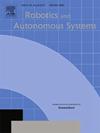Ant-inspired navigation algorithm based on visual landmarks
IF 5.2
2区 计算机科学
Q1 AUTOMATION & CONTROL SYSTEMS
引用次数: 0
Abstract
This paper describes a method for mobile robot navigation that is similar to the navigation mechanism of social insects. Unlike other bio-inspired methods that mimic certain morphological features of animals or separate natural mechanisms, the proposed approach is based on the phenomenology of the behaviour of some ant species during collective foraging. This method does not require a map, but allows a robot to memorize a path from the "nest" to the food resource based on visual landmarks, compass data (the skylight compass in insects) and the time component. The path is represented by a sequence of movements that takes the robot from one support landmark to another, as in ants. The remembered route allows the robot not only to return to the starting point, but also to repeat the route. The path built by the robot is not optimal, and the robot repeats this path approximately. However, the method does not require precise positioning and high accuracy of the sensors. The developed route description format is compact, because it only contains a sequence of directions to support landmarks, distances to them, and the amount of time the robot spent on the way from one landmark to another. A key feature of this solution is the implementation of route transmission from the scout to the forager via low-speed communication channels, for example, using the RC-5 infrared communication protocol. The method has been tested in simulations and on real robots in an indoor testing ground. In addition, due to specific architectural and technical solutions focused on modeling behaviour and the use of dimensionless parameters, the transition from simulation models to the management of technical objects (robots) can be made without the physical modeling stage, which makes development easier and cheaper.
基于视觉地标的蚁群导航算法
本文描述了一种类似于群居昆虫导航机制的移动机器人导航方法。与其他模仿动物的某些形态特征或单独的自然机制的生物启发方法不同,所提出的方法是基于某些蚂蚁物种在集体觅食过程中的行为现象学。这种方法不需要地图,而是允许机器人根据视觉地标、罗盘数据(昆虫的天窗罗盘)和时间分量来记忆从“巢穴”到食物资源的路径。路径由机器人从一个支撑地标到另一个支撑地标的一系列运动来表示,就像蚂蚁一样。记住的路线不仅可以让机器人回到起点,还可以重复这条路线。机器人构建的路径不是最优的,机器人会近似地重复这条路径。但该方法对传感器的定位精度要求不高。开发的路线描述格式很紧凑,因为它只包含一系列支持地标的方向、到地标的距离以及机器人从一个地标到另一个地标所花费的时间。该方案的一个关键特点是通过低速通信信道实现从侦察器到觅食器的路由传输,例如使用RC-5红外通信协议。该方法已在室内试验场的模拟和真实机器人上进行了测试。此外,由于专注于建模行为和使用无量纲参数的特定架构和技术解决方案,可以在没有物理建模阶段的情况下从仿真模型过渡到技术对象(机器人)的管理,这使得开发更容易和更便宜。
本文章由计算机程序翻译,如有差异,请以英文原文为准。
求助全文
约1分钟内获得全文
求助全文
来源期刊

Robotics and Autonomous Systems
工程技术-机器人学
CiteScore
9.00
自引率
7.00%
发文量
164
审稿时长
4.5 months
期刊介绍:
Robotics and Autonomous Systems will carry articles describing fundamental developments in the field of robotics, with special emphasis on autonomous systems. An important goal of this journal is to extend the state of the art in both symbolic and sensory based robot control and learning in the context of autonomous systems.
Robotics and Autonomous Systems will carry articles on the theoretical, computational and experimental aspects of autonomous systems, or modules of such systems.
 求助内容:
求助内容: 应助结果提醒方式:
应助结果提醒方式:


